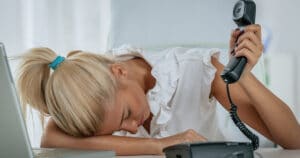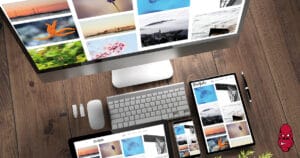Did you know that an about page is the second most popular and important page on your website, second only to your home page? That makes it pretty important! It’s not just about sharing the history of your company, though.
You can also use this as an opportunity to convince customers to take action by pointing out the benefits you have to offer! After all, people came to your website to see if you can solve their problems and give them what they want or need, right?
The actual name of your “About” page can vary. It can be called “About Us”, “About Me”, “About the Company” or just “About”. This is largely a personal preference. You just want people to find it easily and quickly.
Why You Need an About Page
Did you know that most people just skim the pages of a website, looking for the benefits you have to offer them? This is your chance to make a personal connection with your audience.
A good about page is going to help you with Google EAT – Expertise, Authoritativeness, and Trustworthiness. A strong Google EAT score is going to help your website rank better in search engine results.
What You Need to Know – Your about page can help you connect with customers and impress Google if you can demonstrate the pillars of EAT. This means you will attract more people because Google will move you up the ladder of the search engine results page.
How to Begin Your About Page
Begin your page with a blanket statement, like a mission statement – something that shows what you’re all about. You have to catch their attention within seconds; sometimes that’s all you have to grab them! Imagine you can jump out of your computer and literally yank them by the collar and tell them to listen! Now, picture what you would say to them to keep their attention.
The good news is you’ve already won half the battle. They have arrived at your about page and are ready to read what you have to say. The fact that they are reading the page means that they want to invest more time in learning about you and/or your company and how you can best meet their hopes, dreams, desires, and/or needs.
Now is the time to explain what the essence of your business is, but don’t stop there! You need to tell them how you will meet their wants and needs with the products and/or services you offer. Why should they care what you have to say? Make them hungry for more!
For example, you might want to say, “We created [product/company name], so people could [benefits of your services/products].” Do you see how that statement both told a little bit about the company and explained how their customers benefit from their products and/or services?
What You Need to Know – Start with a statement that will grab their attention. Focus on explaining what you do and how you can help the level of their happiness.
How to Tell Your About Story Without Boasting
Once you have come up with your initial statement, you can introduce yourself or your business, depending on the purpose of your about page. Make it interesting by perhaps adding a little humor in it, but keep your content customer-focused. With everything you write, you’ll want to introduce some of the perks people may receive if they decide to do business with you.
1. You are an expert.
The most important part of telling your story is your proof of how you are an authority on your topic and have the level of expertise that you have earned. People want to know they have reached the right person or company.
You want people to understand how and why you are an expert in your industry, so they will trust you with their business. Impress readers, because, like most people, your potential customers want to work with experts – people who know what they’re talking about. They need to know you will do an accurate, solid job with whatever you sell or do.
You can show proof you are an expert with testimonials, notable accolades, case studies, links to published/complete work, rewards you have received, customer reviews, customer feedback, and any media outlets that have covered stories about you.
For further explanations of your expertise, you can list how many clients you’ve helped, which continents you’ve worked in, or how many products you’ve sold. That will show you have experience in the industry. Just try to think about what you’d want to know if you were in their shoes.
If you don’t have any proof of your expertise, take screenshots of the work you’ve done for others or talk about how happy the people you worked with are.
Some companies even include a “behind the scenes” or “how we work” video on their about page, describing exactly what they do for customers. Visuals on your website are a great way to interact with your audience!
If you are particularly good with words, you may be able to say what you need to with text, but an about page video is sure to be watched! Remember that people don’t have the attention span that you may think they do. They will just skim words and watch videos or look at pretty images, so try to include plenty of visuals!
So, what can you include in a video or creative text? Think of yourself as a host, letting people into your house. What do visitors see and do when they enter? Pretend you are their host, showing them all about you and how you are a unique individual.
Explain what it’ll be like when they choose to work with you. You want visitors to get what they want from your about page; that is, to learn what you actually do for your clients. If they see you can provide a product or service for someone else, they will know you can meet their similar needs!
2. You are different from the competition.
The second pillar of creating a winning story on your about page is explaining to your audience how you are unique. They need to understand how you are different from the competition. Telling your story gives you this chance – an opportunity to stand out and make people want to choose you over what else is out there.
Remember to remain at least a little mysterious, though. You are just giving them a taste, not the whole buffet. You don’t need to tell your whole life story in that one little page. Make it a short summary of your best features and, most of all, what you have to offer the reader.
If you feel the need for a long biography, include it at the bottom of the page. Write a condensed version or an introduction and put that at the top. Give them a taste and let them decide if they want to scroll down to read the whole story.
A very important part of your story is figuring out how to cleverly tell them about who you are in a way that actually means something to them. Show your personality and explain, for example, how you used to be in the readers’ shoes, what you did to find solutions to your problems and the success you’ve realized because of what you did or bought.
Explaining your journey will earn you trust, making customers want to join in to be a part of a journey like yours! What was your “before,” and how can you help them achieve a successful “after” like you did? You might say, “I went through exactly the same thing…” or, “I know first hand…”
3. You are trustworthy.
The third aspect of your story is that you’ll need to prove that you are a trustworthy person. As they read about you, just as if you were face-to-face, they will get to know you and start to trust who you say you are (and hopefully, the proof that backs that up).
You can build trust, authority, and expertise by explaining your experience. These are the three elements of Google EAT (expertise, authoritativeness, and trustworthiness), an important part of SEO that Google uses to rank your website on the search engine results page.
As you’re telling your story, answer the following questions.
- What has turned you into the person you are today?
- What is the story behind your business?
- Why did you start or join the business you’re in?
- What can customers expect when doing business with you?
- Who do you help, and why do you enjoy helping them?
- How many customers have you served?
The Most Important Piece of an About Page
With your story, you explained three very important pieces of information. First, you have shown that you are an authority or expert in your field or industry.
Second, you have explained in what ways you are different from the competition. You are a unique individual.
Finally, you have proven that you are trustworthy – one of the three pillars of Google EAT.
Now, you are ready to learn about the most important part of an about page, which is showing the audience the benefits you have to offer. Can you help them with what they want or need?
With every part of your about page, you should be tying it back to customer benefits. What can you offer? If you have a mission statement or a section listing your values or philosophy, make sure they are worded in a way that you can show you help people.
You might explain that: At [company name], we help [target audience] to achieve [results/benefits for the customer].
Ask yourself the following questions.
- What can you do to help your potential customers?
- What perks might they realize?
- How do you help others? What’s your process?
- What’s in it for them?
Include a Call to Action
It’s crucial that you lead the audience into taking action. They may be excited about you but don’t have a clue what to do next. You must give them a call to action here.
You may want them to write a review, shop at your online store, or opt into your mailing list. Ask them to book a free consultation or join a mailing list.
Are you still trying to figure out what to add as your call to action? Try one of these suggestions:
- Review My Free Resource
- Check Out My Blog
- Listen to My Latest Podcast
- Read Success Stories
- Schedule a Consultation
- Check Out My Other Pages
- Send Me a Message
- Follow Me on Social Media
- Hit My Shop
Example of a Winning About Page
Creating an about page isn’t as hard as you might think. The company, Yellow Leaf Hammocks, has mastered the art of creating an about web page where potential customers can read how they can be helped.
If you read it, you’ll notice that the nuggets of information all tie back to customer benefits. The business owners are able to achieve lead generation through unique selling tactics. Notice how the page is spread out, easy to read, and fun!
Not only that, but the company gives readers a chance to briefly read about their story, the journey that led them to their current state, and even a solid call to action at the bottom. They also did a great job explaining why they do what they do, who they’re helping, how they’re unique, and a “meet the team” section that allows you to dig deeper if you want.
They explain what their company culture is like, give customers plenty of ways to take action and join the company on social media. They have included many calls to action (CTA), so the customers know where to go next.
Have you ever gone to a very cool website only to feel overwhelmed with the decision of where to go next? They are clear about this aspect, making the next step a simple one.
Remember the example of you being a “host” at your home? Well, this applies here, too. You need to show your guests what to do next. At home, when you have people over, don’t you offer them a drink or a place to sit?
The same idea holds true here. Be a good host to the visitors of your website.
Tips for Writing Your About Page
You’ve been introduced to a lot of information, but no article would be complete without a few tips for when you write your about page.
- Formatting – Make sure you use short paragraphs and plenty of white space. Break up your text with bulleted and numbered lists.
- Tone – Make sure you are speaking as you would in a conversation. Use simple words and easy-to-grasp concepts. You want to be relatable to the average reader.
- Image – Include a high-quality, professional image of you. This way, people can see there’s a person behind the curtains.
- Editing – Don’t forget to proofread your about page. It’s actually a good idea to let someone else (or more than one person) read it and give you input.
- Be Authentic – Let readers see that you are a real person!
- Reinforce Your Brand – Every brand has a unique story or voice behind it.
- Your Story – Avoid telling a long-winded story about your past. People want to know how you got into this line of work, of course, but keep it concise.
- Personality – Explain your personal journey and show you have personality.
- Elevator Pitch – Treat your about page as short as what you’d say to a person in an elevator. Make sure your first paragraph really “hooks” the reader. This will make them want to learn more about you and what you have to offer them.
The Perfect Formula for an Ace About Page
Step One: Include your mission statement or what your company values are.
Rent the Runway has a great blanket statement to start their about page. Check it out.
“Our mission is to make women feel empowered and self-confident every single day.”
Step Two: Tell your story.
Yellow Leaf Hammocks told their story in a very concise way. That’s what you want. Here is their story:
“In 2011, while on vacation in Thailand, our co-founder Joe embarked on an impromptu motorcycle adventure that led him to discover the world’s most comfortable hammock hanging outside a hut on a tiny island.”
Step Three: Make sure your content has customer benefits all over. Ideaware’s about page is covered with benefits for potential customers. Be sure that you do this in every part of your about page.
Step Four: Include a call to action to tell them what to do next. Amy Porterfield has lots of ways to take the next action on her website. For example, she has a link that says, “Check out one of my special how-to guides.”
Step Five: Keep it concise and have a little fun! Check out Cultivated Wit’s about page for some hints on how to do this!
Ready to Get Personal?
It’s okay if you don’t have a lot of information for your about page. You can add personal details, so people know who you are and what you’re like. Include books you’ve read or places you want to visit. Show that there is a human behind the business, and you are happy to explain who you are and how that applies to what you can do for them.
FAQs
What if I don’t have a “story” to tell in my about page?
Everyone has some kind of story. You had a journey that helped you become the person you are today, an adventure that got you into the industry you’re in, and a motivation that keeps you going strong in what you’re currently doing. Discuss all of those things if you don’t feel like you have a proper “story” to tell.
What can you include in an about page if you don’t have any experience?
There are many things that you can talk about to prove your worth to your audience. How have the passions in your life brought you to writing this about page?
Why did you become the person you are today? Don’t be afraid to be a little vulnerable; people want to do business with real people. This is your chance to humanize your brand a little.
Shouldn’t my “about page” be professional only?
While it’s a good idea to be professional, depending on your industry, you should also show a little personality. You can achieve a great deal of influence by simply sharing who you really are. It’s a good idea to let people in and show them there’s a person behind the business. People want to trust those they do business with.
What should the tone be on my about page?
Try writing in the first person, provided that works for your industry, because people want to see that you are a real person. You may want to add a few sentences from the personal journey that got you to be the person you are today.
How can I build credibility with my about page?
Make sure you mention testimonials of satisfied customers and include company logos, showing which companies you have worked with. If you have formal education, you can point out your training, certifications, notable achievements, and diplomas.
To Sum It Up
If you are ready to change or create your about page, don’t forget the main pillars of creating a fantastic about page. Most importantly, you want to emphasize customer benefits and what they can do next (the call to action).
Are you ready to amp up your website with a killer about page? Ready to overhaul your entire website? Get started today by contacting Angry Ape Creative!
We can help you create the website you have been after since day one! Allow Angry Ape Creative to help you find a solution to your design and marketing needs. Check out the services we offer for more information.
Jay Bilunas is a graphic designer and marketing consultant. He loves helping small businesses succeed with great marketing and design. He also teaches and tries to help up and coming designers.
- Jay Bilunashttps://angryape.com/author/angryape/
- Jay Bilunashttps://angryape.com/author/angryape/
- Jay Bilunashttps://angryape.com/author/angryape/
- Jay Bilunashttps://angryape.com/author/angryape/







-300x158.png)


